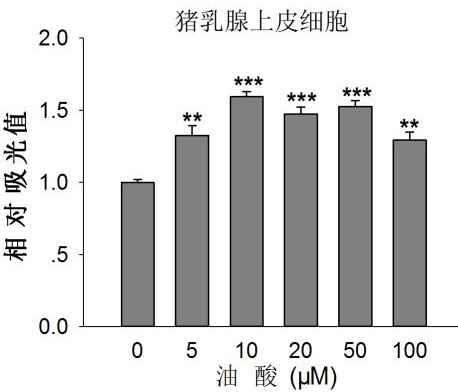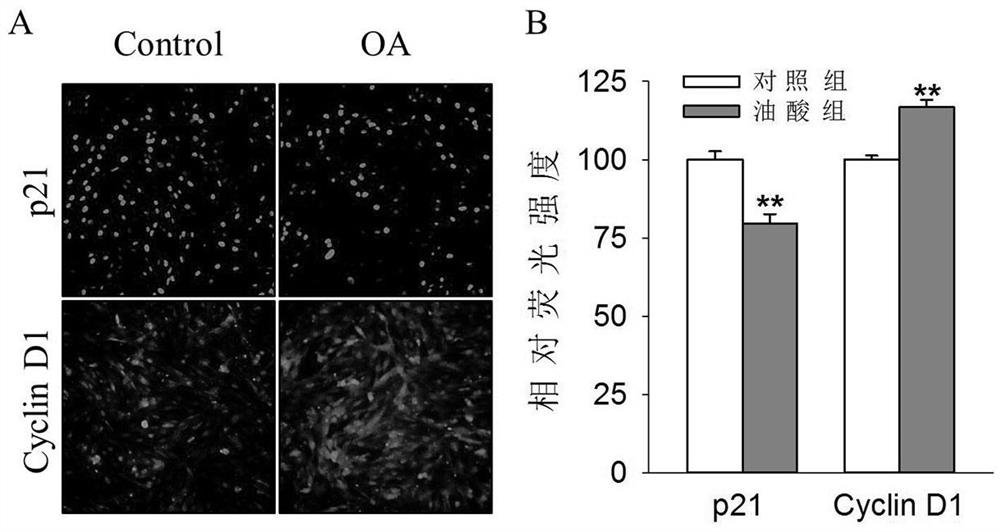Application of Oleic Acid in Promoting Animal Mammary Gland Development
A mammary gland development and oleic acid technology, applied in the application, animal feed, medical preparations containing active ingredients, etc., can solve the problems affecting the popularization and application of oleic acid, achieve good popularization and application prospects, promote cell proliferation, and add less amount Effect
- Summary
- Abstract
- Description
- Claims
- Application Information
AI Technical Summary
Problems solved by technology
Method used
Image
Examples
Embodiment 1
[0032] Example 1 Oleic acid promotes the proliferation of porcine primary mammary epithelial cells
[0033] 1. In order to study the effect of oleic acid (OA) on the proliferation of mammary gland epithelial cells, the experiment first took pig primary mammary gland epithelial cells as the research object:
[0034] (1) Porcine primary mammary epithelial cells were cultured in DMEM-F12 medium containing 10% fetal bovine serum;
[0035] (2) Porcine primary mammary epithelial cells were treated with oleic acid (5, 10, 20, 50, 100 μM); the solvent of different concentrations of oleic acid was absolute ethanol.
[0036] (3) Cells were collected, and the cell proliferation phenotype was detected by MTT.
[0037] 2. The results are attached figure 1 shown. The results showed that 5-100 μM oleic acid could significantly ( P <0.05) to promote the proliferation of porcine mammary epithelial cells.
Embodiment 2
[0038] Example 2 Oleic acid promotes the proliferation of mouse mammary epithelial cells
[0039] 1. In order to further study the effect of oleic acid (OA) on the proliferation of mammary epithelial cells, mammary epithelial cells HC11 were used as the research object, and HC11 cells were cultured in RPMI-1640 medium containing 10% fetal bovine serum. The above HC11 cells were treated with different concentrations of oleic acid (12.5, 25, 50, 100, 200 μM).
[0040] (1) The effect of oleic acid on the proliferation of mammary epithelial cells was determined by MTT detection method.
[0041] The results are attached figure 2 As shown in A. The results showed that oleic acid promoted the proliferation of HC11 cells in a dose-dependent manner, and the effect of promoting cell proliferation was the best at 100 μM and 200 μM.
[0042] (2) HC11 cells were treated with 100 μM oleic acid for 4 days, and the proportion of HC11 cells in S phase was detected by EdU.
[0043] The res...
Embodiment 3
[0049] Example 3 The effect of adding 2% oleic acid on the mammary gland development of puberty mice in the diet
[0050] 1. Experimental method
[0051] (1) Animal feeding conditions: 1 animal / box, single-breeding; feeding temperature and humidity: 20-26°C, 40-70%; 12 h: 12 h day and night intermittent lighting; the conditions of the breeding room are always kept stable to ensure the experiment reliability of the results. Free access to food and water, feed and drinking water were provided by the Guangdong Provincial Medical Experimental Animal Center; Quarantine: The purchased SPF grade C57BL / 6J mice were pre-fed for 7 days. Animals were checked once a day during this period.
[0052] (2) Animal grouping and treatment: 4-week-old mice were randomly divided into normal control group and oleic acid group, 10 in each group, totally 2 groups. Mice in the normal control group were fed normal diets, mice in the oleic acid group were fed normal diets supplemented with 2% oleic a...
PUM
 Login to View More
Login to View More Abstract
Description
Claims
Application Information
 Login to View More
Login to View More - R&D
- Intellectual Property
- Life Sciences
- Materials
- Tech Scout
- Unparalleled Data Quality
- Higher Quality Content
- 60% Fewer Hallucinations
Browse by: Latest US Patents, China's latest patents, Technical Efficacy Thesaurus, Application Domain, Technology Topic, Popular Technical Reports.
© 2025 PatSnap. All rights reserved.Legal|Privacy policy|Modern Slavery Act Transparency Statement|Sitemap|About US| Contact US: help@patsnap.com



